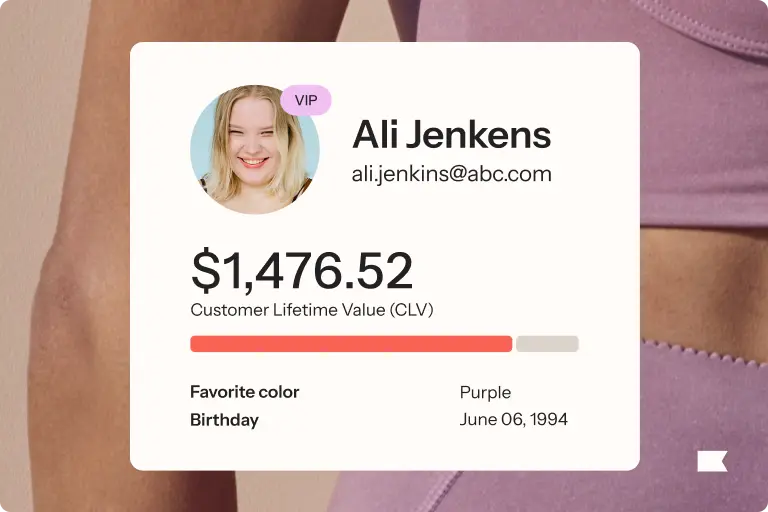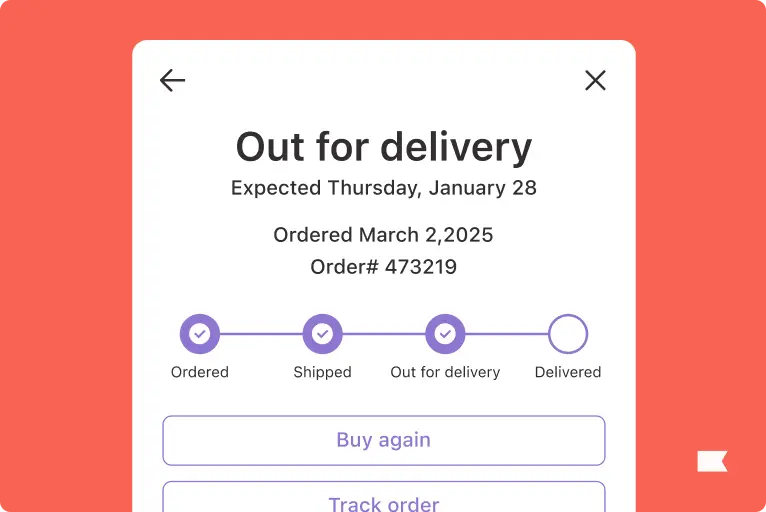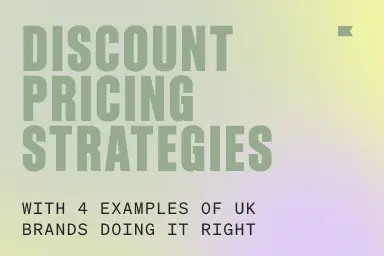How to convert ecommerce customers to a subscription model
What do Netflix, Amazon Prime, and a dusty old gym membership have in common? People happily pay for them every single month. So why is it so hard for brands to turn one-time buyers into recurring subscribers?
For ecommerce retailers, the prospect of getting a steady stream of revenue each month is very welcome. As well as generating a predictable income, subscriptions can strengthen customer relationships and present regular opportunities to engage with shoppers throughout the month.
The hard part is convincing shoppers to commit to a monthly subscription. With so much competition, getting someone to buy from you once is hard, let alone make a repeat purchase.
The challenge of bringing back one-time buyers
Whatever way you look at them, subscriptions can solve a frustrating problem—not least because we want to avoid the inconvenience of missing out. We don’t want to run out of our favourite coffee, face cream, or snacks, nor do we want to wait a week for deliveries.
It seems like an easy sell. But, while many brands pump their time, money, and effort into converting buyers once, the thought of having to convince the same buyer to come back can be daunting.
Faced with so much choice, today’s consumers are constantly on the hunt for better deals, more targeted offers, and improved experiences. It feels like you can’t drop the ball for even a second, otherwise your competitors will swoop in with a targeted social ad or a discount for new customers.
But with a solid plan and a goal to create repeat business, you might find subscription models are a hit for your customer base. After all, the benefits can far outweigh the cons for both sides:
- Consumers never run out of their favourite products and can get generous deals by becoming top customers.
- Brands can increase customer lifetime value (LTV), decrease customer acquisition costs (CAC), generate predictable revenue, and grow a loyal base of repeat buyers.
How to nurture a customer relationship and create repeat business
Customer relationships are at the core of a successful subscription model. Customers should want to return time and time again because they can’t get the same product, deal, or experience elsewhere.
This is why nurturing customer relationships is a pivotal part of generating repeat business. Even if your product isn’t the cheapest on the market, if a customer has an enjoyable experience and feels connected to your brand, they’re not going to jeopardise that by jumping ship for the sake of a few pounds.
Understand individual customer needs—and communicate based on those
The very basics of customer nurturing involve understanding the unique wants and needs of each customer. Someone who needs a subscription is going to have different priorities than someone who only wants to buy a product ad-hoc.
At a simple level, you can identify shoppers who regularly purchase the same product at similar intervals—e.g. someone who buys a specific face cream six weeks apart or someone who comes back every couple of months to invest in a certain flavour of coffee.
These are shoppers that might benefit from a subscription, especially if it saves them money and the hassle of having to remember to reorder their favourite products.
Use these purchasing intervals and behaviour to personalise your communication. This shows shoppers you know what they want and that you’re one step ahead of their needs.
Give shoppers a reason to subscribe
There has to be a benefit for customers to sign up for your subscription model—and this benefit might be different for different customers. Again, you can use past data to determine the purchasing patterns of shoppers.
Here are some reasons people might want to subscribe:
- To save money if they buy the same product regularly
- To remove the hassle of having to reorder
- To treat themselves each month
- To try new products without spending hours on research
When nurturing customers, your goal should be to determine their key motivator. Someone who wants to save money might benefit from unique discount codes or exclusive offers, while someone who wants to treat themselves might respond better to messaging around self-care.
Whatever their motivation, give shoppers a reason to subscribe. Make the benefits abundantly clear and use customer data to personalise your nurturing strategy so it aligns with individual shopper priorities.
Skincare brand Dermalogica works hard to engage its customers after they’ve subscribed. “What I always say to people is, it’s your opportunity to resell the value of staying subscribed,” says Sophie Murray, Dermalogica’s Customer Success Manager at Klaviyo. “When you think about the messaging you want to give your customer, think about what benefits they get as a Dermalogica customer that’s subscribed versus the benefits of a customer that’s not subscribed.”
Start small with a free gift or starter kit
It’s hard to get a new customer to invest in your brand month after month, which can make it difficult to get your subscription off the ground. Instead of trying to capture customers in a multi-month model, start small.
Give hesitant customers a reason to choose your brand and take small steps to show them why they should opt for your products over a competitor’s.
Here are some ways you can start small:
- Send a starter kit. Give customers an introduction to your product range with a small starter kit made up of key products.
- Offer a free trial. Give customers a taster of what’s to come with a month’s free subscription.
- Send a free gift. Let customers sample other products in your range for free.
- Add a discount. Give customers money off their first month’s subscription or offer an ongoing incentive if they lock in for a certain period of time.
Dollar Shave Club is well-known for offering a starter kit that introduces shoppers to its product range.
It’s a similar story for Dermalogica, a brand that doesn’t offer discounts but does send freebies to give customers a feel for the product. “We always want to get the product in the customer’s hands,” says Frankie Warner, Dermalogica’s Head of CRM. “We know once we’ve done that the quality of the product will shine through and we can probably convert them.”
How to sell a subscription model in a way that feels genuine
Subscriptions should be a win-win for both sides, not a way to strong-arm shoppers into making repeat purchases. When you take the time to get to know customers, their priorities, and their motivators, it’s much easier to sell subscriptions in a way that feels genuine and on-brand.
Don’t assume shoppers know the details
One big hesitation for shoppers is not understanding what they’re buying—especially if they’re expected to buy into a multi-month subscription with barely any information.
It’s easy to assume people know about subscriptions and what they involve (because we all partake in them in some shape or form—hello, Netflix), but sometimes you have to spell it out to remove any lingering hesitations. After all, you’re asking customers to commit to a recurring monthly payment. They need to know what’s in it for them and exactly how it works.
You should answer the following questions (and more!):
- Can I pause my subscription?
- What if I don’t like the products? Can I cancel?
- Do I have to sign up monthly or can I change the schedule?
Make sure you cover these questions (and any others that might crop up) in your subscription messaging.
Loot Crate uses a step-by-step format to explain what customers get, how often they get it, and important delivery information.
Offer a guarantee
Guarantees reassure customers they can either duck out or get their money back if they’re not happy. Adding a guarantee to your subscription shows customers you value them and understand their potential hesitation to invest in your brand month after month.
You can add a money-back guarantee so shoppers get a full refund if they don’t enjoy the product. This builds trust and encourages shoppers to see it as a risk-free investment. And, that if they do enjoy the product, they’ll probably keep buying from you.
Personalise offers
80% of people who consider themselves frequent buyers say they only purchase from brands that personalise their experience and 56% say they’ll become repeat buyers after a personalised experience.
It’s a no-brainer. Customers are more likely to come back if they feel understood and are served a journey made just for them.
Use customer data to deliver recommendations or allow customers to customise their subscriptions to meet their needs.
Dermalogica customers receive a personalised email welcome series that runs separately from the standard welcome flow. These emails take into account the customer’s unique skin concerns and recommend products and practices best suited to their needs.
“All of the data gathered from Klaviyo informs Demalogica’s segmentation, including product launches and email campaigns, as well as more targeted messaging,” says WarnerFrankie. Since taking a more personalised approach to nurturing subscribers, the brand has seen a 4.3% rise in click rates.
Be flexible
Ultimately, every shopper is different. Not everyone needs the exact same product at the exact same time every month. This is why it’s important to be flexible with your subscriptions so that they can be as useful as possible to customers.
The easiest way to do this is to make it simple for customers to amend, pause, or speed up their subscriptions on a rolling monthly basis.
Dog food subscription Butternut Box clearly states that customers can pause, push, or cancel their plan at any time.
The 5 most common ecommerce subscription models
Different brands call for different subscription models. While consumables might need replenishing regularly, other brands might fare better with thoughtfully curated boxes to showcase their product range.
Here are the most common subscription models.
1. The replenishment model
Replenishment subscriptions remind shoppers they might be running out of their favourite products. It’s most common for brands that sell consumable goods, like toiletries, food, or coffee.
The replenishment model can be used to send a one-time reminder or it can be a recurring offer for customers. For example, Dermalogica uses buyer data to calculate when a customer is on the verge of running out of a product. This triggers an email promoting the subscription service that delivers the product to your door, hassle-free, whenever you need it.
Balance Me uses a similar tactic. The brand uses data in Klaviyo to determine the likely repurchase interval of a product and sends a replenishment email to foster repeat purchases. This has resulted in an 83% increase in repeat purchases.
2. The curated subscription box
Curated boxes are often comprised of several products and give customers the chance to explore different products each month. Sometimes curated boxes are based on a shopper’s unique interests and needs, or they can be generic boxes sent out based on a monthly theme.
For example, Bird & Blend sends subscribers three new tea blends each month.
3. The personalised subscription box
Personalised boxes are tailored to a customer’s unique interests or needs. This gives shoppers a chance to explore different products and delivers a unique experience—think brands like Stitch Fix and BirchBox, both of which tailor their boxes based on customer data.
Stitch Fix encourages shoppers to take a style quiz to personalise subscription boxes based on size, tastes, and other key attributes.
4. The subscribe and save model
This model encourages shoppers to subscribe to get a discounted rate on their favourite products. For example, they can either buy their favourite face cream or coffee blend at full price, or they can save 10% or 20% if they sign up to receive the product every month.
Kiehls gives shoppers a 10% discount (and free shipping) if they choose to subscribe and save instead of paying full price.
5. The access subscription
This subscription model lets customers sign up to receive access to products they otherwise wouldn’t have access to. It creates the feeling of an exclusive membership and doesn’t necessarily deliver products every month—instead, customers pay a recurring fee to unlock access (or deals and discounts) on products not available to the general public.
Beauty Pie is a prime example of a brand using this model. Customers can pay a monthly subscription fee to access a changing menu of products each month.
Turn one-time buyers into subscribers
Subscription models are beneficial to both brands and shoppers—the former get a steady revenue stream while the latter get access to their favourite products every month.
The key to converting one-time buyers into long-term subscribers is understanding their key motivators and purchasing patterns. Use customer data to discover purchasing intervals and top products, and feed this information into your marketing. Use it to deliver triggered replenishment emails at just the right time or create personalised boxes geared towards each shopper’s unique interests and needs.

Related content

Acquisition is harder and ads cost more—so how do smart brands keep growing? Learn how customer value optimisation (CVO) helps you turn first-time buyers into loyal, high-value customers.

With rising acquisition costs, customer retention is more crucial than ever. Discover 8 strategies from Klaviyo to boost ROI and keep customers loyal.

Discover Klaviyo’s ultimate guide to discounting pricing strategies for Black Friday.